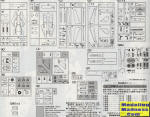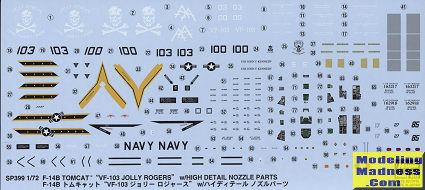
| KIT #: | 52199 (SP 399) |
| PRICE: | 5400 yen delivered |
| DECALS: | Two options |
| REVIEWER: | Scott Van Aken |
| NOTES: | 2019 Limited Edition |

| HISTORY |
With time, the early versions of all the missiles were replaced by more advanced versions, especially with the move to full solid-state electronics that allowed better reliability, better ECCM and more space for the rocket engine. So the early arrangement of the AIM-54A Phoenix active-radar air-to-air missile, the AIM-7E-2 Sparrow semi-active radar homing air-to-air missile, and the AIM-9J Sidewinder heat-seeking air-to-air missile was replaced in the 1980s with the B (1983) and C (1986) version of the Phoenix, the F (1977), M (1982), P (1987 or later) for Sparrows, and with the Sidewinder, L (1979) and M (1982). Within these versions, there are several improved batches (for example, Phoenix AIM-54C++).
The Tactical Airborne Reconnaissance Pod System (TARPS) was developed in the late 1970s for the F-14. Approximately 65 F-14As and all F-14Ds were modified to carry the pod. TARPS was primarily controlled by the Radar Intercept Officer (RIO) via an extra display for observing reconnaissance data. The "TARPS Digital (TARPS-DI)" was a 1996 upgrade featuring a digital camera. The digital camera was further updated beginning in 1998 with the "TARPS Completely Digital (TARPS-CD)" configuration that also provided real-time transmission of imagery.
Some of the F-14A aircraft underwent engine upgrades to the GE F110-400 in 1987. These upgraded Tomcats were redesignated F-14A+, which was later changed to F-14B in 1991. To fill the gap in attack types between the retirement of the A-6 and implementation of the F-18E/F, the Tomcat was cleared to use bombs in 1992. In 1994 it was modified to accept the LANTRIN system and its targeting pods.
| THE KIT |

 This
is the standard second generation Tomcat kit with additional bits added that
include a pair of black 3D printed acrylic (resin) exhaust nozzles. Since
showing two black blobs wouldn't be very useful, I have included an image of
the nozzles already painted. This addition along with a sprue from their
weapons set that includes the LANTRIN pods are what make this a special
limited edition kit. While I don't keep up with everything Hasegawa
does, this may be the first time they have included 3D printed parts in a
kit.
This
is the standard second generation Tomcat kit with additional bits added that
include a pair of black 3D printed acrylic (resin) exhaust nozzles. Since
showing two black blobs wouldn't be very useful, I have included an image of
the nozzles already painted. This addition along with a sprue from their
weapons set that includes the LANTRIN pods are what make this a special
limited edition kit. While I don't keep up with everything Hasegawa
does, this may be the first time they have included 3D printed parts in a
kit.
Hasegawa
has reboxed the Tomcat at least five dozen times, judging by my slowly
growing collection of F-14 kits. It was natural that they'd get the most out of
what has to have been an expensive molding, judging by the plethora of small
parts and inserts that come with the kits. There are so many parts that the box is actually bulging in an attempt to
keep them from escaping. You can see the number of bits and pieces from the
image above. In many ways, this is just a smaller version of the larger and
equally impressive 1/48 F-14 that Hasegawa has produced. Typical of Hasegawa,
the kit came with all those sprues in two bags. As a result, there were a number
of parts broken off the sprues and the bits have numerous scratches on them.
As
demanded, the panel lines are engraved and the kit offers the ability to have
the flaps and slats deployed. In fact, to do it otherwise will require a bit of
surgery to be done on the slat tracks. You can also position the glove vanes
open or closed. Again, some surgery is needed for the closed position. All F-14s
had them wired in the closed position after it was realized that they didn't
really do anything and were an additional maintenance hassle. You also have the ability to have the speed brakes and entrance steps/ladder
open or closed, and two different tails, though one set is not for this
particular boxing. So much has the F-14 been modified and updated over the years
that you really need to have photographs of the aircraft that you are modeling
to get everything right.
 As required by its price, this kit comes with a small fret of
etched metal. These bits are for the interior, canopy and exhaust. The metalwork
is very well done and should really enhance your Tomcat. From what I see in the
instructions, you can leave all these things off save for the upper ejection
seat pull handles.
As required by its price, this kit comes with a small fret of
etched metal. These bits are for the interior, canopy and exhaust. The metalwork
is very well done and should really enhance your Tomcat. From what I see in the
instructions, you can leave all these things off save for the upper ejection
seat pull handles.
 Instructions
are standard stuff for modern Hasegawa kits and offer the usual Gunze paint
references. Both markings options are from VF-103's last F-14 cruise aboard
the USS JFK in 2004. Interestingly, aircraft #103 carries the special
notation on the fin as you can see in the box top photo.
The other option is the CAG bird. Both of these have black fins and
cockpit surround. Decals are very nicely done and include instrument decals.
Instructions
are standard stuff for modern Hasegawa kits and offer the usual Gunze paint
references. Both markings options are from VF-103's last F-14 cruise aboard
the USS JFK in 2004. Interestingly, aircraft #103 carries the special
notation on the fin as you can see in the box top photo.
The other option is the CAG bird. Both of these have black fins and
cockpit surround. Decals are very nicely done and include instrument decals.
| CONCLUSIONS |
I am not sure just how many people outside Japan are willing to pay the somewhat premium price for this kit, but I can tell you that the end result is usually stunning. Probably the only thing it really would benefit from are aftermarket seats that have the harness.
| REFERENCES |
https://en.wikipedia.org/wiki/Grumman_F-14_Tomcat
March 2019
Copyright ModelingMadness.com. All rights reserved.
If you would like your product reviewed fairly and fairly quickly, please
contact the editor or see other details in the
Note to
Contributors.
Back to the Main Page
Back to the Review Index Page
Back to the Previews Index Page